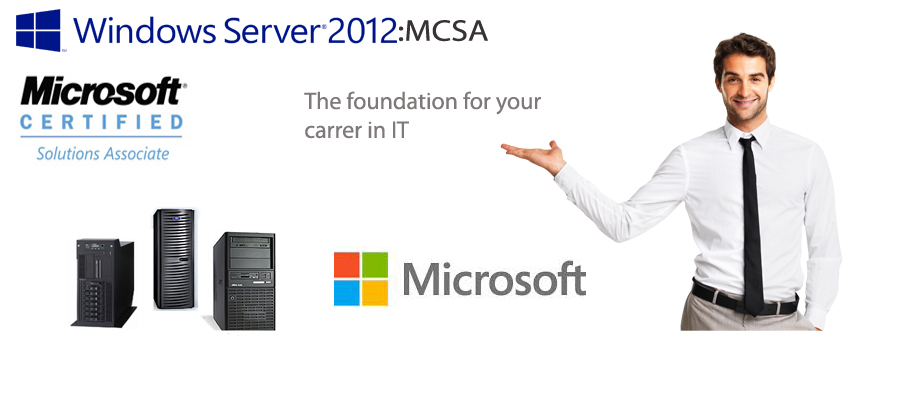Book-1 Installing and Configuring Windows Server
Module 0: Introducing Windows Server 2016
Lesson 1: Installing, upgrading, and migrating servers and workloads
Lesson 2: Preparing and installing Nano Server and Server Core
Lesson 3: Preparing for upgrades and migrations
Lesson 4: Migrating server roles and workloads
Lesson 5: Windows Server activation models
Module 1: Implementing and configuring domain controllers
Lesson 1: Overview of AD DS
Lesson 2: Overview of AD DS domain controllers
Lesson 3: Deploying a domain controller
Module 2: Managing objects in AD DS
Lesson 1: Managing user accounts
Lesson 2: Managing groups in AD DS
Lesson 3: Managing computer objects in AD DS
Lesson 4: Using Windows PowerShell for AD DS administration
Lesson 5: Implementing and managing OUs
Module 3: Advanced AD DS infrastructure management
Lesson 1: Overview of advanced AD DS deployments
Lesson 2: Deploying a distributed AD DS environment
Lesson 3: Configuring AD DS trusts
Module 4: Implementing and administering AD DS sites and replication
Lesson 1: Overview of AD DS replication
Lesson 2: Configuring AD DS sites
Lesson 3: Configuring and monitoring AD DS replication
Module 5: Implementing Group Policy
Lesson 1: Introducing Group Policy
Lesson 2: Implementing and administering GPOs
Lesson 3: Group Policy scope and Group Policy processing
Lesson 4: Troubleshooting the application of GPOs
Module 6: Managing user settings with Group Policy
Lesson 1: Implementing administrative templates
Lesson 2: Configuring Folder Redirection, Software Installation, and Scripts
Lesson 3: Configuring Group Policy preferences
Module 7: Securing Active Directory Domain Services
Lesson 1: Securing domain controllers
Lesson 2: Implementing account security
Lesson 3: Implementing audit authentication
Lesson 4: Configuring managed service accounts
Module 8: Deploying and managing AD CS
Lesson 1: Deploying CAs
Lesson 2: Administering CAs
Lesson 3: Troubleshooting and maintaining CAs
Module 9: Deploying and managing certificates
Lesson 1: Deploying and managing certificate templates
Lesson 2: Managing certificate deployment, revocation, and recovery
Lesson 3: Using certificates in a business environment
Lesson 4: Implementing and managing smart cards
Module 10: Deploying and administering AD FS
Lesson 1: Overview of AD FS
Lesson 2: AD FS requirements and planning
Lesson 3: Deploying and configuring AD FS
Lesson 4: Web Application Proxy overview
Module 11: Implementing and administering AD RMS
Lesson 1: Overview of AD RMS
Lesson 2: Deploying and managing an AD RMS infrastructure
Lesson 3: Configuring AD RMS content protection
Module 12: Implementing AD DS synchronization with Microsoft Azure AD
Lesson 1: Planning and preparing for directory synchronization
Lesson 2: Implementing directory synchronization by using Azure AD Connect
Lesson 3: Managing identities with directory synchronization
Module 13: Monitoring, managing, and recovering AD DS
Lesson 1: Monitoring AD DS
Lesson 2: Managing the Active Directory database
Lesson 3: Active Directory backup and recovery options for AD DS and other identity and access solutions
Book-2 Networking with Windows Server 2016
Module 1: Planning and implementing an IPv4 network
Lesson 1: Planning IPv4 addressing
Lesson 2: Configuring an IPv4 host
Lesson 3: Managing and troubleshooting IPv4 network connectivity
Module 2: Implementing DHCP
Lesson 1: Overview of the DHCP server role
Lesson 2: Deploying DHCP
Lesson 3: Managing and troubleshooting DHCP
Module 3: Implementing IPv6
Lesson 1: Overview of IPv6 addressing
Lesson 2: Configuring an IPv6 host
Lesson 3: Implementing IPv6 and IPv4 coexistence
Lesson 4: Transitioning from IPv4 to IPv6
Module 4: Implementing DNS
Lesson 1: Implementing DNS servers
Lesson 2: Configuring zones in DNS
Lesson 3: Configuring name resolution between DNS zones
Lesson 4: Configuring DNS integration with AD DS
Lesson 5: Configuring advanced DNS settings
Module 5: Implementing and managing IPAM
Lesson 1: Overview of IPAM
Lesson 2: Deploying IPAM
Lesson 3: Managing IP address spaces by using IPAM
Module 6: Remote access in Windows Server 2016
Lesson 1: Overview of remote access
Lesson 2: Implementing Web Application Proxy
Module 7: Implementing DirectAccess
Lesson 1: Overview of DirectAccess
Lesson 2: Implementing DirectAccess by using the Getting Started Wizard
Lesson 3: Implementing and managing an advanced Direct Accessinfrastructure
Module 8: Implementing VPNs
Lesson 1: Planning VPNs
Lesson 2: Implementing VPNs
Module 9: Implementing networking for branch offices
Lesson 1: Networking features and considerations for branch offices
Lesson 2: Implementing DFS for branch offices
Lesson 3: Implementing BranchCache for branch offices
Module 10: Configuring advanced networking features
Lesson 1: Overview of high-performance networking features
Lesson 2: Configuring advanced Hyper-V networking features
Module 11: Implementing Software Defined Networking
Lesson 1: Overview of Software Defined Networking
Lesson 2: Implementing network virtualization
Lesson 3: Implementing Network Controller
Book-3 Installation, Storage, and computer with Windows Server 2016
Module 1: Configuring Local Storage
Lesson 1: Managing disks in Windows Server
Lesson 2: Managing volumes in Windows Server
Module 2: Implementing enterprise storage solutions
Lesson 1: Overview of DAS, NAS, and SANs
Lesson 2: Comparing Fibre Channel, iSCSI, and Fibre Channel over Ethernet
Lesson 3: Understanding iSNS, DCB, and MPIO
Lesson 4: Configuring sharing in Windows Server 2016
Module 3: Implementing Storage Spaces and Data Deplication
Lesson 1: Implementing Storage Spaces
Lesson 2: Managing Storage Spaces
Lesson 3: Implementing Data Deduplication
Module 4: Implementing and configuring Hyper-V and virtual machines
Lesson 1: Overview of Hyper-V Lesson 2: Installing Hyper-V
Lesson 3: Configuring storage on Hyper-V host servers
Lesson 4: Configuring networking on Hyper-V host servers
Lesson 5: Configuring Hyper-V virtual machines
Lesson 6: Managing virtual machines
Module 5: Deploying a d managing Windows and Hyper-V contain rs
Lesson 1: Overview of containers in Windows Server 2016
Lesson 2: Deploying Windows Server and Hyper-V containers
Lesson 3: Installing, configuring, and managing containers by using Docker
Module 6: Overview of high availability and disaster recovery
Lesson 1: Defining levels of availability
Lesson 2: Planning high availability and disaster recovery solutions with Hyper-V virtual machines
Lesson 3: Backing up and restoring by using Windows Server Backup
Lesson 4: High Availability with failover clustering in Windows Server 2016
Module 7: Implementing failover clustering
Lesson 1: Planning a failover cluster
Lesson 2: Creating and configuring a new failover cluster
Lesson 3: Maintaining a failover cluster
Lesson 4: Troubleshooting a failover cluster
Lesson 5: Implementing site high availability with stretch clustering
Module 8: Implementing failover clustering with Windows Server 2016 Hyper-V
Lesson 1: Overview of the integration of Hyper-V Server 2016 with failover clustering
Lesson 2: Implementing Hyper-V VMs on failover clusters
Lesson 3: Key features for VMs in a clustered environment
Module 9: Implementing Network Load Balancing
Lesson 1: Overview of NLB
Lesson 2: Configuring an NLB cluster
Lesson 3: Planning an NLB Implementation
Module 10: Creating and managing deployment images
Lesson 1: Introduction to deployment images
Lesson 2: Creating and managing deployment images by using MDT
Lesson 3: Virtual machine environments for different workloads
Module 11: Managing, monitoring, and maintaining virtual machine installations
Lesson 1: WSUS overview and deployment options
Lesson 2: Update management process with WSUS
Lesson 3: Overview of Windows PowerShell DSC
Lesson 4: Overview of Windows Server 2016 monitoring tools
Lesson 5: Using Performance Monitor

_1.png)
_1.png)














